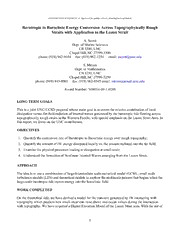
DTIC ADA526909: Barotropic to Baroclinic Energy Conversion across Topographically Rough Straits with Application to the Luzon Strait PDF
Preview DTIC ADA526909: Barotropic to Baroclinic Energy Conversion across Topographically Rough Straits with Application to the Luzon Strait
DISTRIBUTION STATEMENT A: Approved for public release; distribution is unlimited. Barotropic to Baroclinic Energy Conversion Across Topographyically Rough Straits with Application to the Luzon Strait A. Scotti Dept. of Marine Sciences CB 3300, UNC Chapel Hill, NC 27599-3300 phone: (919) 962-9454 fax: (919) 962-1254 email: [email protected] S. Mitran Dept. or Mathematics CB 3250, UNC Chapel Hill, NC 27599-3250 phone: (919) 843-8901 fax: (919) 962-9345 email: [email protected] Award Number: N00014-09-1-0288 LONG-TERM GOALS This is a joint UNC-UCSD proposal whose main goal is to assess the relative contribution of local dissipation versus far-field radiation of internal waves generated by the barotropic tide flowing across topographically rough straits in the Western Pacific, with special emphasis on the Luzon Strait Area. In this report, we focus on the UNC contribution. OBJECTIVES 1. Quantify the conversion rate of Barotropic to Baroclinic energy over rough topography; 2. Quantify the amount of IW energy dissipated locally vs. the amount radiated into the far field; 3. Examine the physical processes leading to dissipation at small scale; 4. Understand the formation of Nonlinear Internal Waves emerging from the Luzon Strait. APPROACH The idea is to use a combination of large/intermediate scale numerical model (GCM) , small scale turbulence models (LES) and theoretical models to explore the multiscale process that begins when the large-scale barotropic tide injects energy into the baroclinic field. WORK COMPLETED On the theoretical side, we have derived a model for the transient generated by IW interacting with topography which predicts how much shear can raise above mid-ocean values during the interaction with topography. We have acquired a Digital Elevation Model of the Luzon Strait area. With the aid of 1 Report Documentation Page Form Approved OMB No. 0704-0188 Public reporting burden for the collection of information is estimated to average 1 hour per response, including the time for reviewing instructions, searching existing data sources, gathering and maintaining the data needed, and completing and reviewing the collection of information. Send comments regarding this burden estimate or any other aspect of this collection of information, including suggestions for reducing this burden, to Washington Headquarters Services, Directorate for Information Operations and Reports, 1215 Jefferson Davis Highway, Suite 1204, Arlington VA 22202-4302. Respondents should be aware that notwithstanding any other provision of law, no person shall be subject to a penalty for failing to comply with a collection of information if it does not display a currently valid OMB control number. 1. REPORT DATE 3. DATES COVERED 2009 2. REPORT TYPE 00-00-2009 to 00-00-2009 4. TITLE AND SUBTITLE 5a. CONTRACT NUMBER Barotropic to Baroclinic Energy Conversion Across Topographyically 5b. GRANT NUMBER Rough Straits with Application to the Luzon Strait 5c. PROGRAM ELEMENT NUMBER 6. AUTHOR(S) 5d. PROJECT NUMBER 5e. TASK NUMBER 5f. WORK UNIT NUMBER 7. PERFORMING ORGANIZATION NAME(S) AND ADDRESS(ES) 8. PERFORMING ORGANIZATION University of North Carolina,Dept. of Marine Sciences,Chapel REPORT NUMBER Hill,NC,27599-3300 9. SPONSORING/MONITORING AGENCY NAME(S) AND ADDRESS(ES) 10. SPONSOR/MONITOR’S ACRONYM(S) 11. SPONSOR/MONITOR’S REPORT NUMBER(S) 12. DISTRIBUTION/AVAILABILITY STATEMENT Approved for public release; distribution unlimited 13. SUPPLEMENTARY NOTES 14. ABSTRACT 15. SUBJECT TERMS 16. SECURITY CLASSIFICATION OF: 17. LIMITATION OF 18. NUMBER 19a. NAME OF ABSTRACT OF PAGES RESPONSIBLE PERSON a. REPORT b. ABSTRACT c. THIS PAGE Same as 3 unclassified unclassified unclassified Report (SAR) Standard Form 298 (Rev. 8-98) Prescribed by ANSI Std Z39-18 climatological data (GFDL) we have calculated maps showing how much the Richardson number can be elevated above the value observed without boundary interaction. Following a discussion at the last meeting in Honolulu, we have also run simulation of linear mode-1 internal waves approching at different angles, to test the hypothesis that NLIWs are generated by the confluence of linear IWs approaching from different directions. RESULTS The model shows that the transient can lead to a large intensification of the shear. The Richardson number during the transient can be elevated up to a factor (ω/(ω−ω))4 above undisturbed levels. c Figure 1 shows a map of the intensification factor for waves at the diurnal frequency and near-bottom stratification from climatology. Interestingly, most of the western ridge is an area of potential dissipation for the IWs at the diurnal frequency whose impact needs to be better understood. Figure 1: Map of the Richardson number intensification factor for Internal Waves at the diurnal frequency. The factor is plotted in logarithmic scale. The map is centered on the Luzon Strait, with the tip of Taiwan to the north. Shallow areas near the Baatan Islands are blocked out. Note the large values attained near the western ridge. Stratification data from GFDL climatology. We have also conducted numerical experiments with the UNC Ocean Model to study the three- dimensional interaction of linear internal wave packets approaching at small grazing angle. This was done to see if the interaction of linear waves coming from different sources within the Luzon Strait can lead to NLIWs by a process of contructive interference. Preliminary results show that this is indeed the case. The goal is to characterize the range of angles that lead to NLIWs. IMPACT/APPLICATIONS We are working towards a better characterization of multiscale processes that take energy from the barotropic field (ultimately, astronomical scales) to dissipation via several nonlinear processes. The 2 theoretical characterization of enhanced shear has far-reaching applications, since IW scattering from topography is a phenomenon which occurs on a global scale, and it is linked to the control of the meridional overturning circulation. It thus has a profound aspect on climate control. RELATED PROJECTS Parts of this project overal with an NSF project on mixing along continental shelf slopes. The overlap mostly consists in the similarity of the technical tools needed. 3
